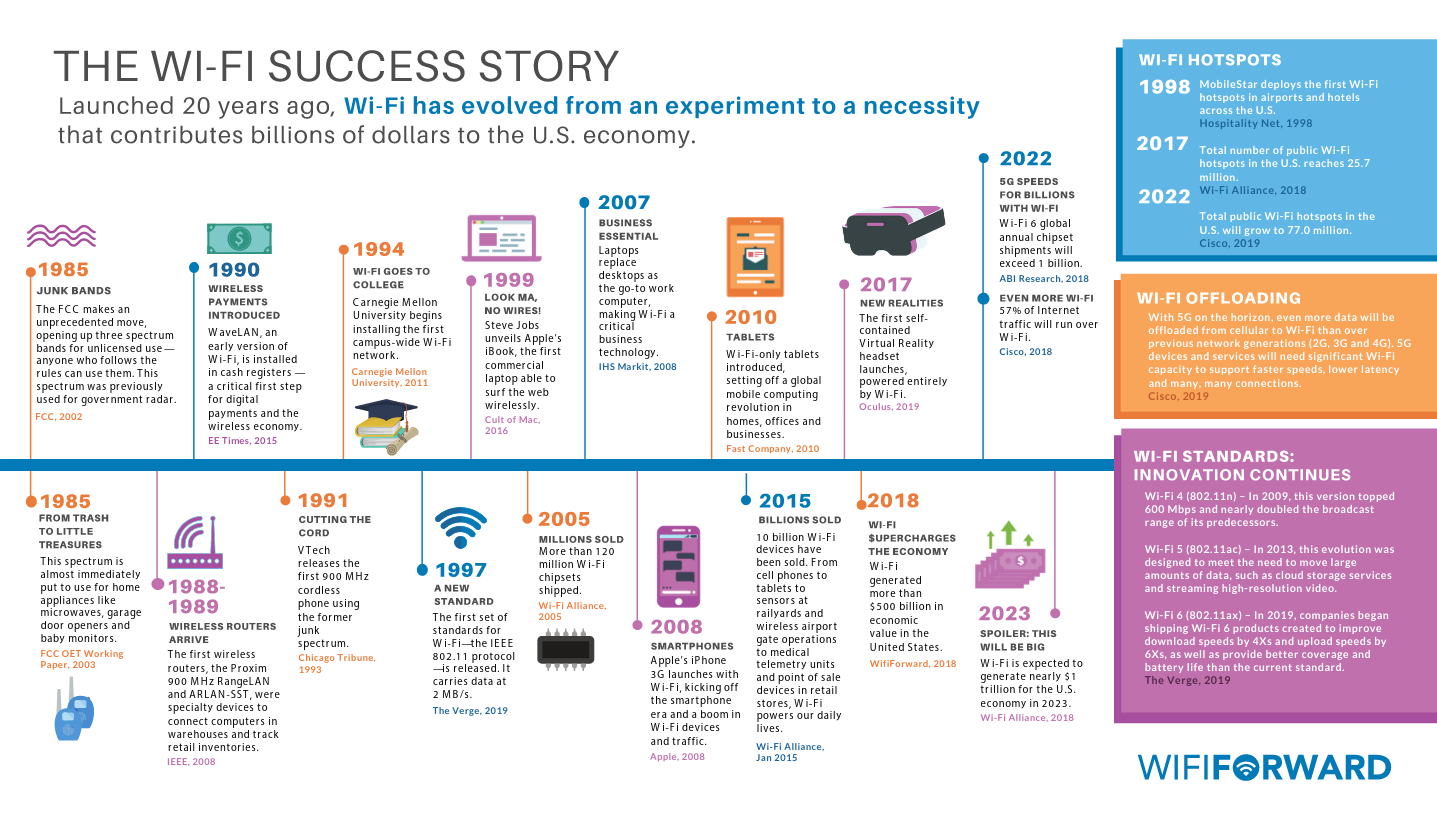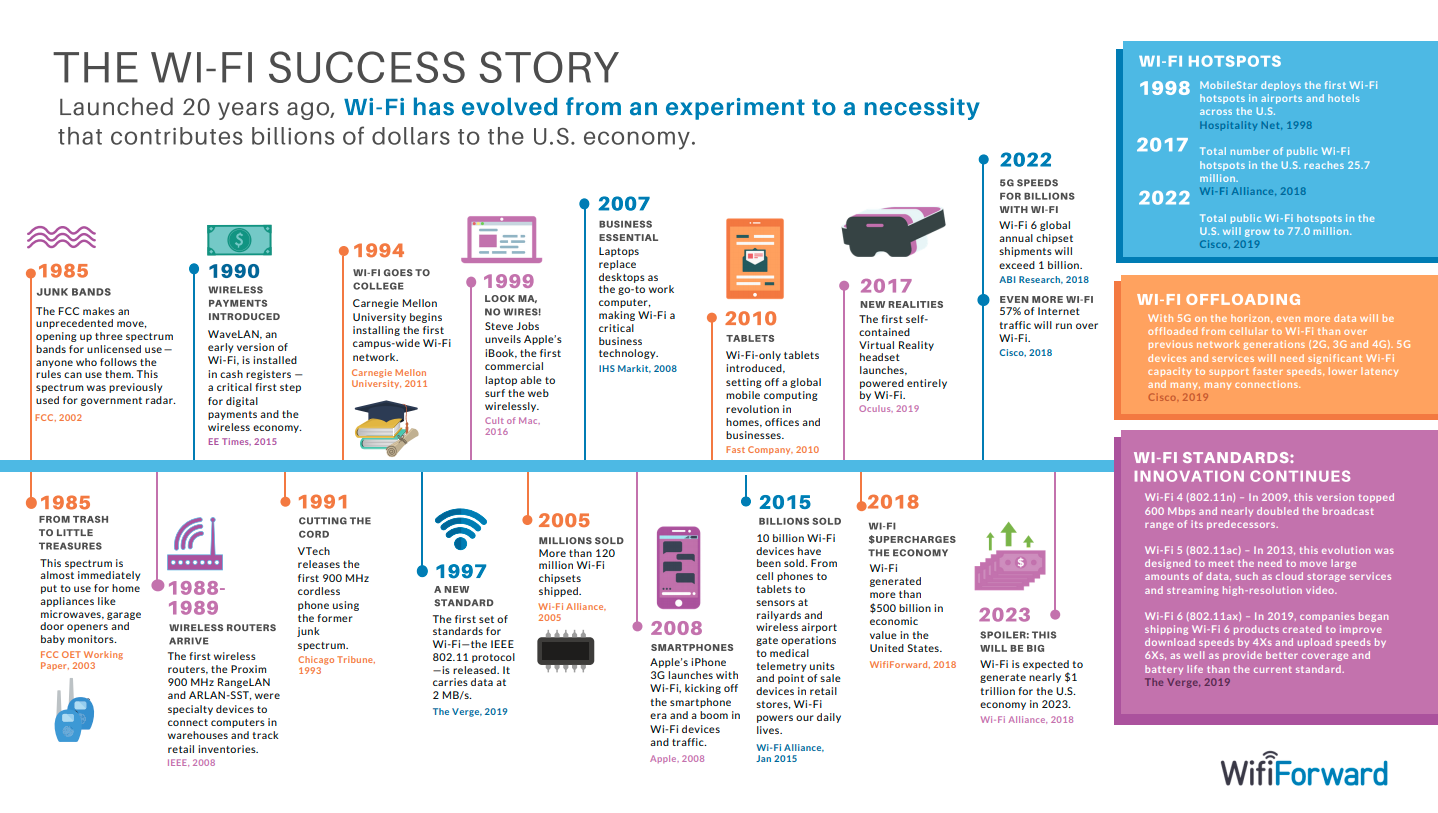

Our world runs on Wi-Fi — a fact that’s even more true now, as the world heals from a global pandemic than it was just a few years ago. Wireless is how we live, work, play, stay healthy and keep connected.
Wireless connectivity runs over airwaves, or radio frequency spectrum. In the United States, licensed bands of spectrum are auctioned off to corporations for exclusive use or assigned for government use, while unlicensed and shared bands allow for more users to fit into the spectrum. It is in these unlicensed bands that Wi-Fi and Bluetooth run.
Because of unlicensed spectrum policy charted by the FCC nearly two decades ago, Wi-Fi has become the most important wireless technology for American consumers and businesses. Multiple studies have found these technologies contribute hundreds of billions to the U.S. economy. One conservative estimate: $834 billion to the U.S. economy in 2020 alone.
Not only does Wi-Fi support communications, web browsing, e-commerce and access to news and entertainment, but it also plays an essential role in connecting hospitals, schools, industrial facilities and transportation hubs. Technologies like Wi-Fi that rely on unlicensed spectrum are critical to broadband access, economic prosperity and access to opportunity. And, as we’ve seen throughout the COVID-19 pandemic, these technologies are only becoming more important to the kind of future we want to build.
But airwaves are limited and this caused a “spectrum crunch” for Wi-Fi. From 2003 until 2020, there was no new spectrum for Wi-Fi in the key mid-bands, but in that time, Wi-Fi became the lifeblood of our wireless economy, carrying the majority of all internet traffic. With the explosion of Wi-Fi and the Internet of Things, unlicensed bands became too crowded.
For Wi-Fi — and other technologies using unlicensed and shared spectrum — to continue to connect us, we need balanced spectrum policy that brings Americans new unlicensed and shared bands.
Commercially launched over twenty years ago, Wi-Fi has evolved from an experiment to a necessity that contributes billions of dollars to the U.S. economy.

Download the timeline here
From the launch of the Wi-Fi-enabled Apple iBook in 1999, consumers were no longer tethered to a cord for work or play online. And in 2008, when the iPhone 3 incorporated both cellular and Wi-Fi connectivity, there was no turning back. Now on its 6th generation, with over 20 feature releases and upgrades, Wi-Fi has become faster and more sophisticated. And as other unlicensed technologies have evolved, everything got “smarter” with tablets, VR headsets, smart refrigerators, security systems and more in our homes. But Wi-Fi and other shared spectrum technologies are also critical to industry: from sensors at railyards and wireless airport gate operations to medical telemetry units and point of sale devices in retail stores, Wi-Fi powers our daily lives.
From humble beginnings in the “junk bands” of our airwaves several decades ago, Wi-Fi has become the lifeblood of our economy, adding more than a trillion dollars in value. Wi-Fi is a workhorse for our communications networks, supporting offloaded mobile traffic and making our cell networks work better. This keeps consumer costs low and will play a huge role in the rollout of 5G networks. In fact, Cisco predicts that by 2022, the majority of global IP traffic will run over Wi-Fi. And with the growing Internet of Things, machines will need more and more of it to communicate with each other.
In 2018, Wi-Fi Alliance announced the rollout of the latest Wi-Fi standard, Wi-Fi 6, which is designed to provide faster, more energy-efficient and more reliable services to power the next generation of tech.
Wi-Fi 6 is a new standard of Wi-Fi that will take the complication out of Wi-Fi naming as this new classification system categorizes the previously-used Wi-Fi names into more understandable Wi-Fi generations:
802.11n (2009) = Wi-Fi 4
802.11ac (2014) = Wi-Fi 5
802.11ax (2019) = Wi-Fi 6
This isn’t just about speed; it’s an all-around upgraded Wi-Fi experience. Not only does Wi-Fi 6 provide faster connectivity, but it also has the ability to support and communicate with dozens of devices at once without causing an overall slow-down, saving battery power during device usage. This means a greater individual Wi-Fi experience in large crowds in places like stadiums and airports.
When used indoors, most devices use Wi-Fi to connect to the internet because it typically works faster and more reliably than using cellular data. Allowing for more devices to connect, and with less buffering, Wi-Fi 6 is a new standard of Wi-Fi that will be four times faster than the current standard. With wider channels and other technical innovations, next-generation Wi-Fi is designed to support data-intensive applications like the many smart home devices or exciting technologies like Augmented or Virtual Reality gaming systems and the IoT.
Routers equipped for Wi-Fi 6 and the first Wi-Fi 6 computers, phones and other connected devices are available today. And routers and devices that can use a brand new swath of spectrum — the 6 GHz band — are available with Wi-Fi 6E.
5G is the next generation of cellular connectivity, set to enable faster uploads and downloads along with improved experiences for apps and services. 5G promises major advances for consumers and businesses, and unlike previous generations, the 5G experience will be fueled by a combination of technologies. Ubiquitous, high speed, high capacity connectivity will be delivered by a variety of advanced wired and wireless technologies, relying on a combination of licensed, unlicensed and coordinated shared spectrum frequencies. All are necessary to win the race to 5G.
Wi-Fi and other unlicensed technologies will do the job of making high capacity, low latency 5G service possible by enabling higher capacity at lower costs and delivering 5G indoors.
According to research by Cisco, cellular 5G networks will send vast amounts of additional data traffic over commercial Wi-Fi networks. With 5G radios, other radio access technologies will be seamlessly integrated with cellular technologies to increase the network capacity. Wi-Fi is a workhorse, supporting offloading from mobile. And with technologies like Passpoint to support this offloading for carriers, consumer costs for 5G technology will be lower than they would be if carriers had to provide 5G using only licensed spectrum.
Wi-Fi will also continue to carry the majority of traffic indoors — and it already has a huge install base, with more devices than people in the world. Enterprises, homes, coffee shops, and airport lounges, for example, will continue to rely on Wi-Fi connectivity. Wi-Fi picks up for cellular coverage indoors, handling important use cases like 4K video streams, AR or VR. This will not change with the roll-out of 5G.
Wi-Fi 6 and other unlicensed technologies are already delivering pieces of the 5G promise today and will remain an essential component of 5G. Creating balanced spectrum policy that brings Americans new licensed, unlicensed and shared bands will be critical to the rollout of 5G and the future of connectivity.